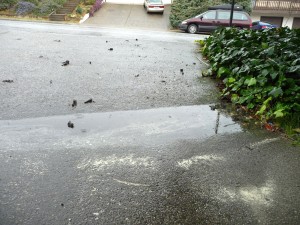
“There’s a sound outside the front door… And I know it’s just the wind… But it makes her snuggle up just a little bit closer… And it starts things happening again…
Steamy windows — zero visibility… Steamy windows — coming from the body heat… Steamy windows – Steamy windows.”
No, this is not a new poem conjured up by a drunk Realtor over the weekend, it’s a Tina Turner song . Remember it? Actually, if you’ve heard it enough times it will spontaneously start playing in your mind upon the sight of steamy windows. That’s what happened to me while walking the neighborhood the other night. I noticed very steamy windows of the house, just dripping with moisture. Now if it was just a bedroom window, then hey, good for them, right? Normally, that steam will be gone in 15 minutes anyways. But when you see this in the living room window, candles lit, fireplace burning, pot cooking you can’t help not to wonder – how can they possibly enjoy breathing that stuff?
Actually, it seems that with all the focus on energy efficiency many times we miss the most important issue of it all – Indoor Air Quality (IAQ). Not only it directly affects our health, we can not have a truly green home without addressing the air that we breathe inside.
EPA says our homes are actually packed with pollutants. Some pollutants cause health problems such as sore eyes, burning in the nose and throat, headaches, or fatigue. Others cause or worsen allergies, respiratory illnesses (such as asthma), heart disease, cancer, and other serious long-term conditions. Hate to be too morbid here, but sometimes individual pollutants at high concentrations, such as carbon monoxide, can even cause death. Bottom line, we must pay attention to this stuff.
By the way, some of the energy-efficient homes today can be so tightly sealed that they can actually be poisoning us more than a leaky home. Some homes might simply not be properly equipped to filter and purify the constantly re-circulated air. Without adequate indoor air circulation, moisture and pollutants build up over time, leading to poor indoor air quality. Steamy windows house is a perfect example.

To simplify this huge topic, keep this advice in mind:
1. Ventilate, ventilate, ventilate. Open the windows often or install mechanical ventilation. Change your furnace filters often. This will prevent moisture build up and many unwanted results associated with it.
2. Enforce a no show policy. The chain of events is obvious. All the pollens, oil, dirt, bacteria gets stuck to our shoes, then we bring it inside, wipe it nicely in the carpets and breath it, touch it, maybe even eat it.
3. Avoid like plague anything that off-gasses the so called VOCs (Volitile Organic Compounds). These include carpets, vinyl, paint, certain furniture, cabinets, cleaning supplies, etc. Industry experts say low levels of VOCs are acceptable and it probably is but why breathe that stuff when we can opt for smarter choices?
4. If you are remodeling or adding square footage, use particle boards, fiber boards and hardwood flooring certified to low-formeldehyde emission standards.
5. When it comes to carpeting, look for a “Green Label” from Carpet and Rug Institute’s IAQ Testing Program. If you have serious allergies, your carpet must go; you’ll feel better in a day.
Most importantly, do your homework before buying anything. Start thinking whether this thing is going to put a damper on the clean indoor air and feed your lungs with toxins for the rest of its lifespan.
We’ll have more much to share with you here on San Jose Green Home backed up with stories from our local IAQ pros. Meanwhile, if you can handle a lot of dry information, check out EPA’s The Inside Story: A Guide to Indoor Air Quality. Stay well and stay healthy.

 The 10 Rules For Being Human and More
The 10 Rules For Being Human and More Rooftop Solar Lease Revisited: 5 Disadvantages or the Facts Leasing Companies Don’t Want you to Know
Rooftop Solar Lease Revisited: 5 Disadvantages or the Facts Leasing Companies Don’t Want you to Know To Ban or not to Ban Plastic Bags in San Jose?
To Ban or not to Ban Plastic Bags in San Jose?